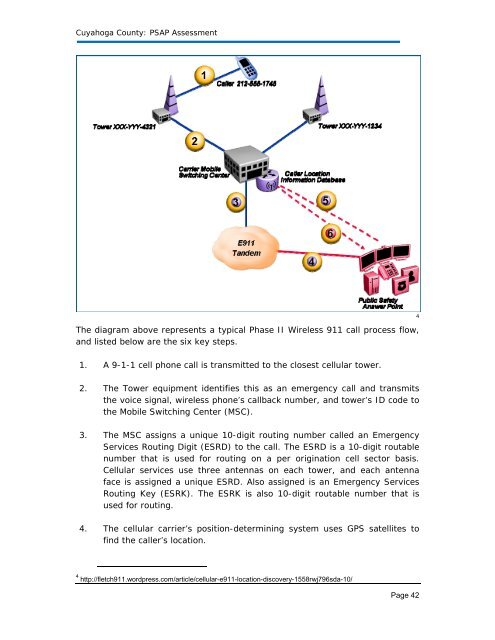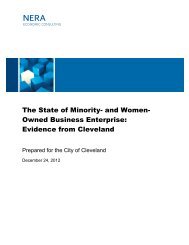Cuyahoga County: Public Safety Answering Point ... - Cleveland.com
Cuyahoga County: Public Safety Answering Point ... - Cleveland.com
Cuyahoga County: Public Safety Answering Point ... - Cleveland.com
Create successful ePaper yourself
Turn your PDF publications into a flip-book with our unique Google optimized e-Paper software.
<strong>Cuyahoga</strong> <strong>County</strong>: PSAP Assessment<br />
The diagram above represents a typical Phase II Wireless 911 call process flow,<br />
and listed below are the six key steps.<br />
1. A 9-1-1 cell phone call is transmitted to the closest cellular tower.<br />
2. The Tower equipment identifies this as an emergency call and transmits<br />
the voice signal, wireless phone’s callback number, and tower’s ID code to<br />
the Mobile Switching Center (MSC).<br />
3. The MSC assigns a unique 10-digit routing number called an Emergency<br />
Services Routing Digit (ESRD) to the call. The ESRD is a 10-digit routable<br />
number that is used for routing on a per origination cell sector basis.<br />
Cellular services use three antennas on each tower, and each antenna<br />
face is assigned a unique ESRD. Also assigned is an Emergency Services<br />
Routing Key (ESRK). The ESRK is also 10-digit routable number that is<br />
used for routing.<br />
4. The cellular carrier’s position-determining system uses GPS satellites to<br />
find the caller’s location.<br />
4 http://fletch911.wordpress.<strong>com</strong>/article/cellular-e911-location-discovery-1558rwj796sda-10/<br />
4<br />
Page 42
















